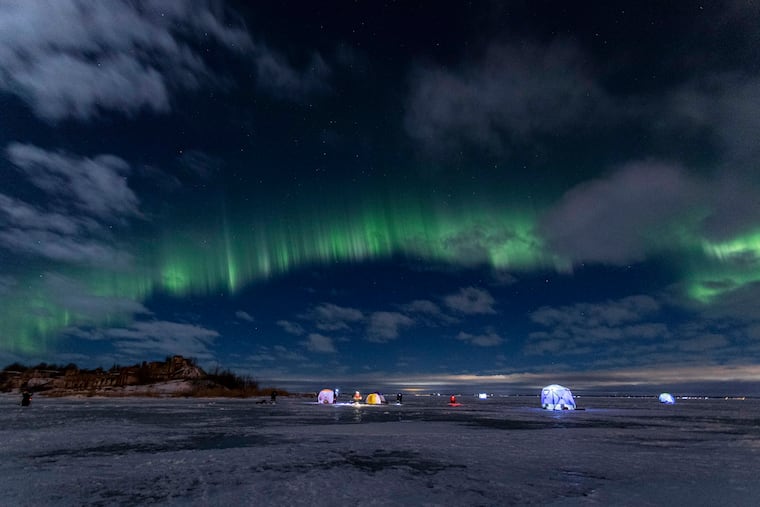Northern lights could be visible over parts of the U.S. But will they make it to Philly?
"It's very angry," a space-weather expert says of the sun. But it probably isn't angry enough to send the northern lights as far south as Philadelphia. Our chance might come later.

» UPDATE: Northern lights are possible again over parts of the U.S. Will Philly ever see these things?
The Atlantic tropics may be quiet, but major storms are brewing on the sun, and it’s at least possible that the northern lights will be visible in parts of the northern United States this week, perhaps as nearby as northern Pennsylvania this evening.
NOAA’s Space Weather Prediction Center issued a geomagnetic-storm warning on Wednesday for “strong” activity with the sun expected to stay in an agitated state for the next few days, said Bill Murtagh, the center’s program director.
“It’s very angry,” said Murtagh, adding that he has counted over a dozen so-called coronal mass ejections, or CMEs, and “the storm has barely begun.”
» READ MORE: Space may be the next tourism frontier
The northern lights — aurora borealis — are ignited by the interaction of CMEs and the earth’s magnetosphere. This particular outbreak is “unusual,” he said. “It just keeps pumping out these mass ejections.
“Sometimes we use the term cannibalistic, where one CME kind of swallows up another because it’s moving faster than the previous one.”
Just how all this would affect a potential light show is uncertain. Auroras are common sights in the polar regions, but especially strong eruptions can drop them into the midlatitudes.
Another “strong” storm is due late Thursday, and that could yank the aurora show as far south as the northern tier of Pennsylvania, according to the Space Weather center, tantalizingly close to the Philly region.
But it is unlikely that they will be visible around here this time around, said Rob Steenburgh, space scientist and acting lead of the space weather office, which is part of the National Weather Service.
“North is better,” he said. He said Philly might have better shots at seeing these things in the months to come as the storm activity revs up.
If they happen, when might the lights be visible?
Space-weather forecasting isn’t quite like monitoring a thunderstorm with Doppler radar (although that also has its pitfalls).
It is unclear when the CMEs will approach the Earth and how strong they will be, or what effects they will have.
» READ MORE: what to know about star-gazing around Philly
“I remind the meteorologists, ‘You guys got the first 10 miles. I’ve got the other 93 million,’ “ Murtagh says.
NOAA’s DSCOVR satellite and its real-time solar wind instruments are on the case.
Should we evacuate?
No, but Murtagh said that Wednesday’s activity ranked as a “G3″ — G for geomagnetic — on the 1-to-5 scale, strong enough to interfere with radio communications and satellite operations.
The strongest storms, G5s, can disrupt power supplies and communications networks, as happened during a storm in March 1989 that knocked out a Canadian transformer and left six million people in the dark for nine hours.
Another G5 storm in October 2003 caused blackouts in Sweden and South Africa.
Better shots ahead
Expect more of these eruptions in the coming months, the experts say.
After a long lull, “sunspot” activity, resulting from strong magnetic disturbances in the sun’s interior, is increasing. Sunspots are associated with higher numbers of magnetic storms.
That means that Philly could eventually get its shots at seeing the northern lights, said Steenburgh.
“Absolutely, there’s hope,” he said. “With winter come longer nights, clear skies after good cold-front passages, and the steadily increasing solar cycle!”
How to track the aurora forecast
The Space Weather center posts three-day outlooks solar storms and the corresponding “Kp Index,” a handy number for tracking aurora potential.
The forecast for Thursday called for a “strong” G3 storm from 5 to 8 p.m. Eastern. The associated Kp number is 7, meaning the lights could be visible in northern Pennsylvania. When the index reaches 8, the Philadelphia area have a decent shot, skies permitting, of course.
The Space Weather center has a handy chart for monitoring the behavior of the index in three-hour intervals, dating back two days.
As Murtagh said, however, this is all a bit more problematic than the average weather forecast.